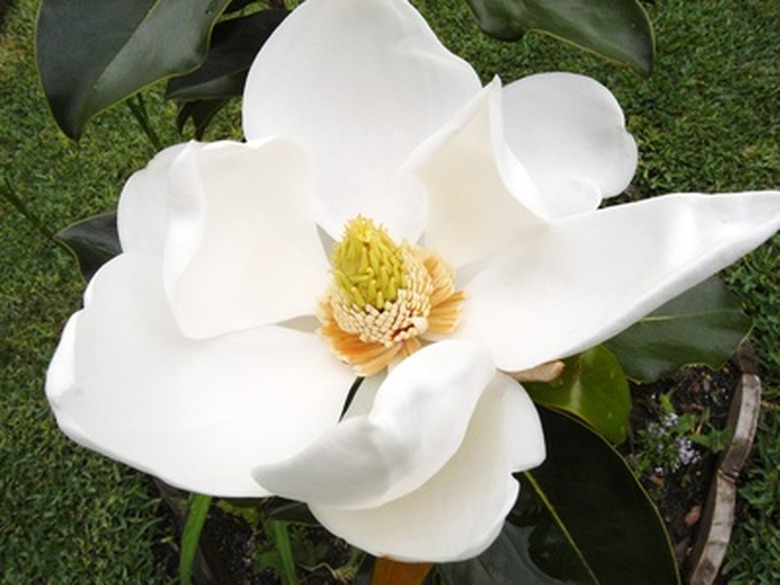Southern Magnolia Varieties
While the wild form of southern magnolia (Magnolia grandiflora) grows upwards of 60 to 80 feet, gardeners may prefer a variety that matures to a smaller size better suited to their residential property. Michael Dirr of the University of Georgia comments that over 150 varieties of southern magnolia have been reported to exist, but less than 40 still exist, and even fewer are available. Grow them in U.S. Department of Agriculture hardiness zones 7 through 10.
Bracken's Brown Beauty
This tree bears leaves with wavy edges and a particularly glossy green color with rusty brown undersides. "Bracken's Brown Beauty" is among the most cold-hardy, growing well into USDA zone 6, according to "Dirrs Trees and Shrubs for Warm Climates." This magnolia grows 30 to 50 feet tall and 15 to 30 feet wide at maturity.
Claudia Wannamaker
A massive tree, upwards of 50 feet tall and 30 feet wide at maturity, "Claudia Wannamaker" develops more branches and a more ornate and picturesque look as it ages.
- While the wild form of southern magnolia (Magnolia grandiflora) grows upwards of 60 to 80 feet, gardeners may prefer a variety that matures to a smaller size better suited to their residential property.
Edith Bogue
Another variety well-suited to chillier parts of USDA zones 6 and 7, "Edith Bogue" bears branches that tend to resist breakage under the weight of heavy snowfalls, according to Michael Dirr. It reaches 30 to 40 feet tall and 15 to 20 feet wide in old age.
Greenback
Although given the unpronouncable variety name of "Mgtig," it can go by the more user-friendly trademark name, "Greenback." This tree grows 30 feet tall and only 12 feet wide, making it a better choice for urban gardens or for a tall hedgerow.
Little Gem
Continuously producing an abundance of flowers from spring to summer, "Little Gem" gains favor among many gardeners and landscape designers, especially since it matures at 20 to 30 feet tall and about 10 feet wide. Flowers even make a scattered appearance into autumn if weather is mild. Later flowers are smaller, though, from 3 to 6 inches in diameter.
- Another variety well-suited to chillier parts of USDA zones 6 and 7, "Edith Bogue" bears branches that tend to resist breakage under the weight of heavy snowfalls, according to Michael Dirr.
- Continuously producing an abundance of flowers from spring to summer, "Little Gem" gains favor among many gardeners and landscape designers, especially since it matures at 20 to 30 feet tall and about 10 feet wide.
Victoria
This variety has its origins in British Columbia, Canada in the 1930s. The foliage has good resistance to winter frost, making "Victoria" a popular selection in the American Pacific Northwest as well as central Europe. It grows 20 to 26 feet tall and 12 to 18 feet wide.
D. D. Blanchard
Sometimes called simply "Blanchard," this variety hails from North Carolina and has glossy green leaves with an underside that is more orange than rusty brown. Maturing at 40 to 50 feet tall and 25 to 30 feet wide, "D. D. Blanchard" does not produce a great number of flowers like other varieties of southern magnolia.
References
- "Dirr's Trees and Shrubs for Warm Climates"; Michael A. Dirr; 2002
- "A-Z Encyclopedia of Garden Plants"; Christopher Brickell and H. Marc Cathey, eds.; 2004
